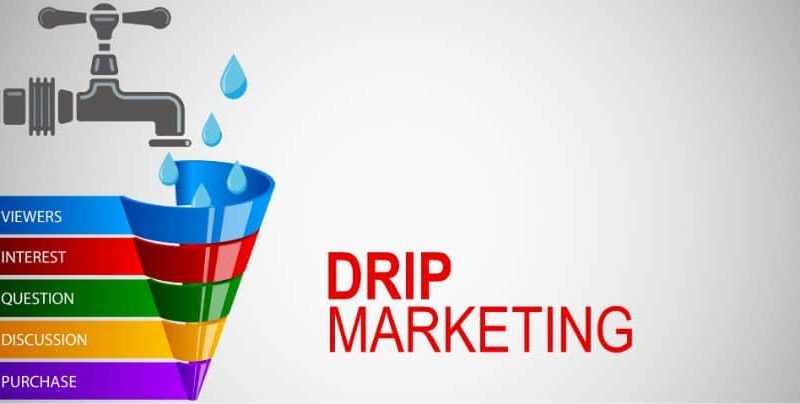Drip campaigns are a type of marketing email that is sent out automatically on a defined schedule. They are also known as drip marketing, automated email campaign, lifecycle emails, autoresponders, and marketing automation. Perhaps one email will be sent as soon as someone joins up, another three days later, and another the following weekend. Alternatively, the emails can be customized based on triggers or activities the individual has taken, such as signing up for your service or making a purchase, which is why they’re also known as behavioral emails.
Setting up drip email marketing campaigns can be intimidating, so we’ve broken down what they are when they’re useful, and how you can use them to grow a customer from a disengaged user in this article.
What Is Drip Marketing?
Drip marketing is a marketing strategy that entails breaking down any type of marketing communication (emails, phone calls, social media posts, brochures, or printed leaflets, etc.) into a series of ‘drips’ spaced out over time.
Drip marketing, automated email campaigns, lifecycle emails, autoresponders, and marketing automation are all terms for the same thing. The notion is the same regardless of the phrase used. Drip marketing, as opposed to outright selling, focuses on creating continuity of connection and, as a result, gently nudging prospects in the direction of completing a purchase.
Drip marketing derives its term from agriculture. It is related to the notion of “drip irrigation,” in which crops are supported by constant, regular, and balanced small-amount watering. This enables the plants to thrive and receive the exact quantity of moisture they require without drying out or overwatering.
The Essential Components of a Drip Marketing Campaign
Now that you understand what a drip marketing campaign is, let’s go over the many components that make it up.
#1. Triggers
Triggers are the events that initiate your drip marketing campaign by either adding a new lead to your pipeline or moving it farther down the funnel. The range and quantity of triggers may vary depending on the specifics of your business. Some of the most common drip marketing triggers are as follows:
- a new blog reader;
- lead generation;
- a potential customer abandoning their shopping cart on the website;
- someone registering for an account in your online store
#2. Situations
Triggers start the campaign and get the gears turning. However, before the engagement actions can begin, several pre-defined conditions must be met. Drip marketing campaign conditions, like triggers, are determined by the marketing manager planning the campaign; thus, they are only limited by the aforementioned manager’s imagination. But if you don’t know where to begin and are looking for some examples, we’ve got you covered:
- sending an email after a lead clicks on a specific link
- Waiting for two days before sending the first email in the sequence.
#3. Taking Action
The actual engagement elements that establish a connection between the business and its customers are referred to as actions in drip marketing. These actions can take the form of emails, SMS messages, social media direct messages, or push notifications, depending on the type of drip marketing in question.
Why Should You Use Drip Marketing?
If you master drip marketing, you can reap a slew of incredible benefits!
To begin, consider the following figures:
- Drip campaign open rates are typically 80% higher than single send emails, with three times the average click-through rates.
- Drip marketing campaigns provide 50% more sales-ready leads.
- Companies who use marketing automation successfully create 80 percent more sales at a 33 percent lower cost.
- Nurtured leads are 43 percent more likely to purchase than non-nurtured leads.
- The click rate on triggered emails is 141.6 percent greater than the click rate on business-as-usual emails.
But where do all those amazing figures come from, and how does drip marketing produce such amazing results? Here’s an overview of the specific effects of implementing a drip marketing strategy for your company.
#1. It boosts participation.
Emails triggered by user activities are more likely to be opened than bulk-send email marketing efforts. You may not only send a personalized, well-crafted email to advertise your company and relevant items, but you can also get a reaction from your consumers.
#2. It automatically propels leads down the funnel.
Drip marketing increases productivity by saving time and, as a result, money for your company. With marketing automation, you can automatically move leads toward conversion without involving an employee.
#3. It takes away the annoyance of prospects.
Cold-calling or cold-emailing can be beneficial, but it will surely disrupt your prospects’ day. This might irritate people and create unfavorable associations. However, this is not the case with triggered emails! Take, for example, Russel from the Pixar film ‘UP’: the boy scout approached the perfect prospect but at the wrong time. He eventually got what he wanted, but to be honest, it could have been much easier if he had used some drip marketing there!
#4. It allows for cross-selling and up-selling.
You can gain a loyal customer who will make repeat purchases if you extend your drip campaign beyond conversion. As a result, more sales!
#5. It raises brand recognition.
Last but not least, if you show up in your leads’ inboxes regularly, you put a reminder about yourself in their heads and keep them there for a longer period of time. Profit!
You can successfully use drip marketing into your approach regardless of your objectives. Drip marketing programs have proven to be very efficient for the following tasks:
- Nurture as a leader
- Welcoming
- On-boarding
- Shopping Carts That Have Been Abandoned
How to Carry Out a Drip Marketing Campaign
One of the best aspects of drip marketing campaigns is how simple they are to implement. These, like every other email marketing campaign, drip marketing can be broken down into several critical components, with effective completion of each resulting in a fantastic campaign!
#1. Determine Your Target Audience
First and foremost, you must understand your target audience: who they are, what they want (including what they don’t realize they want), and how they behave. This phase is required for any marketing campaign, but it is especially critical for drip marketing campaigns because it allows for a more personalized approach to each member of the target demographic. Market segmentation allows you to have a deeper knowledge of the groups that make up your target audience and what motivates them.
Drip marketing is based on two forms of segmentation based on triggers. You can segment the target population based on action triggers or demographic triggers.
- Action-trigger-based segmentation indicates that you structure your drip campaign by categorizing people into groups depending on how they interact with your company. For example, when they first register, you give them a welcome email, and once they make a purchase, you send them a receipt with shipping details and several up-selling possibilities.
- Demographic-trigger segmentation entails tracking consumer behavior and encouraging leads toward conversion. It is heavily focused on past transactions, cart abandonment, and prolonged inactivity after registration.
Furthermore, analyzing the market and combining the results of your analysis with the population you want to target allows you to define specific SMART goals. You will also be able to outline the aims of your drip marketing strategy as a result of this. Do you want to concentrate on lead nurturing? Do you want to increase conversion and persuade prospects to buy your products or services? So, do you want to build a strong relationship with your customers? In one way or another, establishing the basic goals of your campaign allows you to establish the framework of actions required to attain them.
#2. Create Your Message
Once you’ve decided who you want to target with your drip campaign, you can start thinking about what message you want to send them. Drip marketing focuses on providing ‘the correct information at the right time,’ so make sure your content is of the best quality and relevant to the cause. It is critical that your messaging adds value to prospects and is overall appealing to them.
At this time, you should begin writing your initial drafts. You should be able to answer the question of what you want the recipients of your emails to do based on the goals of your campaign. Do you want people to spend more time on your website, or do you want them to learn about the new fantastic product you just released? Depending on the response, you must write an actionable, appealing, and clear copy of the letters you will send out later.
#3. Plan Your Campaign
At this point, you should have all of your messages ready to go. The challenge at hand now is to ensure that they all flow together and do not contradict one another. The basic goal of drip marketing is to maintain communication continuity over time. As a result, when designing your campaign, you must space out your emails in such a way that they continue to arrive and remain relevant!
Here is a list of questions to consider when developing a drip marketing campaign:
- How many emails will I send during the campaign?
- When am I going to send each of these emails?
- What order will I send them in?
- Do all of my emails correspond to the indicated triggers?
- How will I evaluate the success of my campaign?
#4. Begin the Campaign
When everything else is hot and ready, you can launch the campaign and begin sending emails.
Here’s an expert tip: launch your campaign with the help of CRM software to achieve the greatest results and dramatically increase your productivity. Given that we’re discussing email drip marketing, the ideal option is, of course, an email CRM system. For example, you can automate bulk sending, schedule emails, and segment recipients all from within your inbox!
#5. Evaluate Initial Results and Fine-Tune the Campaign
Last but not least, evaluate the preliminary outcomes. Even if you are a drip marketing expert and use a CRM system to automate the campaign, this does not imply you can sit back and relax. If you want to stay on top of your game, you must regularly monitor the success of your campaign and alter it to achieve the best potential results!
Drip Marketing FAQ’s
What do you call email marketing?
Email marketing is a subset of internet marketing, which includes online marketing through websites, social media, blogs, and other channels.
How much does drip cost?
Drip starts at $19 a month for up to 500 contacts, and it offers pay-as-you-go SMS options beginning at $15 for 1,000 sends.
How many emails can be in a drip campaign?
Your drip campaign can consist of four to eleven emails sent four, seven, or fourteen days apart. Determine the number of touches required to effectively nurture your audience and prime them for your offer.
Related Articles
- Email Marketing Platforms: Overview, Common Features, Comparisons
- WHAT ARE THE BEST EMAIL MARKETING SERVICES in 2021? (Updated)
- EMAIL MARKETING TOOLS: The Top 10+ Automation Tools (+Free Tips)
- EMAIL MARKETING SERVICES: Overview, Comparisons, Review & Top picks
- BEST EMAIL MARKETING FOR SMALL BUSINESS: Top 19 Picks (+ Detailed Guide)






